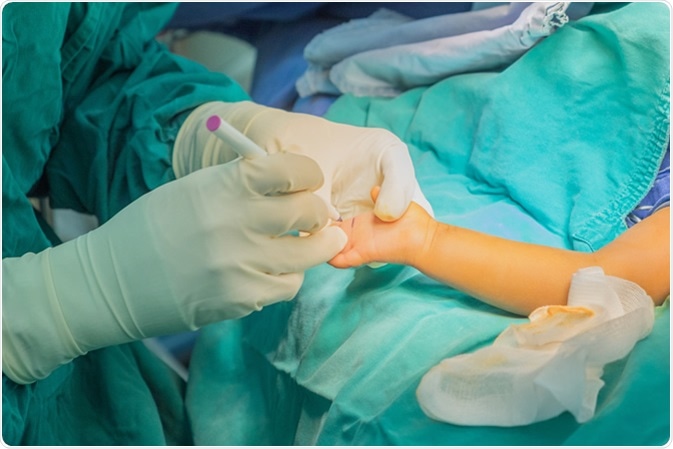Syndactyly, an infrequent condition in human beings, is a state where fingers or toes are joined together. Such condition is normal (connected only by skin) in terrestrial mammals such as kangaroos, dogs, and cats, in many water-habitat birds, like ducks, and in amphibians like frogs. However, a similar condition is rare in human beings, and it is even rarer for the fingers or toes to be connected by bones. In only 1 among around 3000 children, this condition occurs.
During the first stage of prenatal development in humans, all the fingers and toes are fused. However, during 6-8 weeks, cells' death occurs as a normal and controlled part of an organism's growth or development. At this stage, the webbing disappears due to the dissolution of the tissue between the digits by an enzyme.
In few cases to date, the exact reasons for webbed fingers and toes are unknown. Genetically acquired traits are thought to be a cause since relative members frequently share this condition. However, the chances for only one member in a family to have syndactyly are also commonly seen.

Hand surgery in Syndactyly. Image Credit: Samrith Na Lumpoon / Shutterstock
Causes of Webbed Fingers and Toes
During the sixth or seventh week of pregnancy, the child’s hands and feet in the uterus begin to split and form fingers and toes. This is unsuccessful in the case of webbed fingers and toes, which lead to digits that are combined. Webbing can be associated with hereditary defects of both Down and Apert syndromes, which lead to unusual development of the bones in the hands and feet.
Different types of webbing caused are;
- Incomplete webbing: Inappropriate webbing that takes place partially between the digits.
- Complete webbing: Webbing in which the skin is linked in the entire path up the digits with all the necessary parts.
- Simple webbing: Digits joined together by skin or soft tissues.
- Complex webbing: Digits connected by bone or cartilage (the soft and hard tissue).
- Complicated webbing: Digits linked with soft and hard tissue in an abnormal shape (bones missing in between).
syndactyly - congenital hand differences - Boston Children's Hospital
Webbing Connected with Abnormalities
- Down syndrome: This is a hereditary disorder caused when cell division is not normal and results in extra genetic material from chromosome 21. It causes a different facial appearance, affects the mental process of abstract thinking, and delays growth mostly in the age group from 14-18 and above 60 years.
- Apert’s syndrome: This abnormality is characterized by a dysmorphic face and severe webbing of the hands and feet. One gene of the first 22 non-sex chromosomes from either of the parents is responsible for the condition, which leads to an autosomal disorder.
- Carpenter’s syndrome: Development problems that include premature fusion of craniosynostosis (skull bones) and finger and toe abnormalities are characterized as carpenter’s syndrome. It is similar to Grieg cephalopolysyndactyly syndrome, which is a disorder that affects the limbs' growth.
- Amniotic Band syndrome or constriction band syndrome: This is a condition in which strands from the amniotic sac get separated and wound on digits or other parts of the fetus. It is a complicated process that ranges from mild to severe. In mild cases, a band may cover something up around the fetus's fingers or toes, which results in amputations of the digits. A band that folds an arm or leg may result in limited movement with a clubbed foot to occur in severe cases. Most often, an amniotic band tightly winds around a limb, which gradually leads to the stoppage of blood flow.
- Cornelia de Lange Syndrome: The reduced development that happens before and after birth and leads to the abnormal condition of the bones in the arms, hands, and fingers is categorized as Cornelia de Lange Syndrome. Most people are affected individually and have behavioral issues; the growth stage affects their social and communication approach. Apart from these, heart defects and eye problems are also found in some people along with this condition.
- Fetal Hydantoin Effect: Children born with this syndrome may have a non-uniform small size during birth with high development of hair on the face and body. This condition also shows lessened growth of toe and fingernails. Prenatal Hydantoin Syndrome is caused by the exposure of the fetus to Dilantin.
- Timothy syndrome: The co-occurrence of both webbing at a birth rate of ~0.03% is the sign conspicuous for this syndrome. This syndrome is unusual during birth and leads to childhood multisystem disorder. Patients exhibit various growth defects that include webbing and it can also be associated with congenital disorder, genetic syndrome, and cardiac arrhythmia, in which the QT timing lasts longer.
Apart from the above list of rare conditions, more than 50 distinct syndromes are linked with webbing of the digits. It is advisable to consult the physician right at the beginning to overcome this situation.
Further Reading
Last Updated: Feb 4, 2021